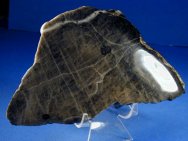| |
It
is common to think of Australia when stromatolites are mentioned
owing to the famous Shark Bay living stromatolites, as well as
the bacterial microfossils and molecular fossils found in inland
Australia that date to before 3 billion years ago. In fact, however,
American North, South and Central) has numerous outcrops of stromatolites
spanning across the continent as well as geological time. Older
stromatolites are particularly abundant in the Northern states
of Wisconsin, Michigan and Minnesota dating from about the upper
Archaean to the Lower Proterozoic, including expansive banded
iron formations that stand as testament to the rusting of the
earth.
The
American stromatolites image gallery below has specimens that
have been cut and polished to a mirror finish. While rough stromatolites
are generally dull and unremarkable in appearance, the fine polishing
renders the inherent beauty of the oldest fossils on earth, including
a myriad of colors and much variation in form genera and lamination
structure.
Phanerzoic
Stromatolites: Paleozoic
|
|
|
|
|
Yelma
digitata
Lower
Cambrian
Arbuckle Mountains, Oklahoma |
Girvanella-like
form genera
Lower Cambrian
Chambliss Limestone, Marble Mountains, California |
|
|
|
|
Girvanella
form genera
Lower Cambrian
Carrea Formation, Racheal, Nevada; adjacent to Area 51 |
Middle
Cambrian
Marjum Formation, Milliard County, Utah
From the famous Cambrian trilobite locality |
|
|
|
|
Cryptozoan
rosemontensis
Lower Ordovician (495 million years old)
Oneota Formation, Monroe County, Wisconsin
By this time in geological history, microbial
communities consisted of complex consortia of both prokaryotic
and eukaryotic forms with diverse metabolic needs, and
competition for resources and differing motility among
them made for an intriguing microcosm of interacting life,
some autotrophic, some chemotrophic and some heterotrophic. |
Somphospongia
sp.
Carboniferous
Jackson County, Kansas
By the time it was formed, the cyanobacterial
organisms and their stromatolitic reef systems were becoming
quite restricted on earth, having retreated to environments
less favorable to other marine life (including other microorganisms,
algae and animals) with which they competed or from which
they suffered predation. |
|
|
|
|
Cryptozoan
sp.
Lower Ordovician (495 million years old)
Oneota Formation, Appleton, Wisconsin
The form genera of the laminae is rather unusual having
resemblance to cauliflower. The pattern is very attractive.
|
Brecciated
Basal Stromatolites
Blue Agate
Lower Ordovician (495 million years old)
Oneota Formation, Buffalo County, Wisconsin |
Girvanella
Form Genera
Silurian - (420 million years old)
Salina Formation, Wood County, Ohio
The oval to circular structures in these images are bacterial
fossil nodules, referred to as Girvanella. |
Meteorite
Impact Fallback Breccia Ordovician Stromatolites
Lower Ordovician (495 million years old)
Oneota Formation, Glover's Bluff, Wisconsin
These stromatolites were formed during the Glover's Bluff
meteorite strike during the Ordovician |
Phanerzoic
Stromatolites: Mesozoic
|
| |
|
|
|
| |
Oncolite
Upper Cretaceous
Lady of Angels Lake, near Ascension, State of Chihuahua,
Mexico
Of interest from a scientific perspective
is the young age. This dinosaur-age, Cretaceous stromatolite
was formed long, long after stromatolite-building organisms
had to compete with other life forms, and hence had become
uncommon on earth, similar to modern times. The microorganism(s)
that form this stromatolite is unknown. Perhaps it was
photosynthetic cyanobacteria, other prokaryotic bacteria,
Eukaryotic algae (often considered a simple plant), or
perhaps some combination of these types of organisms competing
to survive in a not-so-friendly aquatic environment.
|
|
Phanerzoic
Stromatolites: Cenozoic
|
| |
|
|
|
| |
Chlorellopsis
sp.
Middle Eocene
Green River Formation
Tipton Shale Member
Green River
Basin, Wyoming
Specimen has been polished by wind and
sand. May be of algal biogenic origin. |
Chlorellopsis
sp.
Eocene
Green River Formation, Colorado
Interestingly, this Cryptozoon type stromatolite
was very likely to have been built by plant-like green
or red, algae (Chlorophycophyta), as opposed to cyanobacteria
(that are Eubacteria). It is hypothesized that red and
green algae appeared some 800 million years ago having
acquired chloroplasts from eukaryotes through endosymbiosis
to carry out photosynthetic metabolism using sunlight
for their energy needs.
|
| | Stromatolites
Images by Marlene Garo |
| | |





















